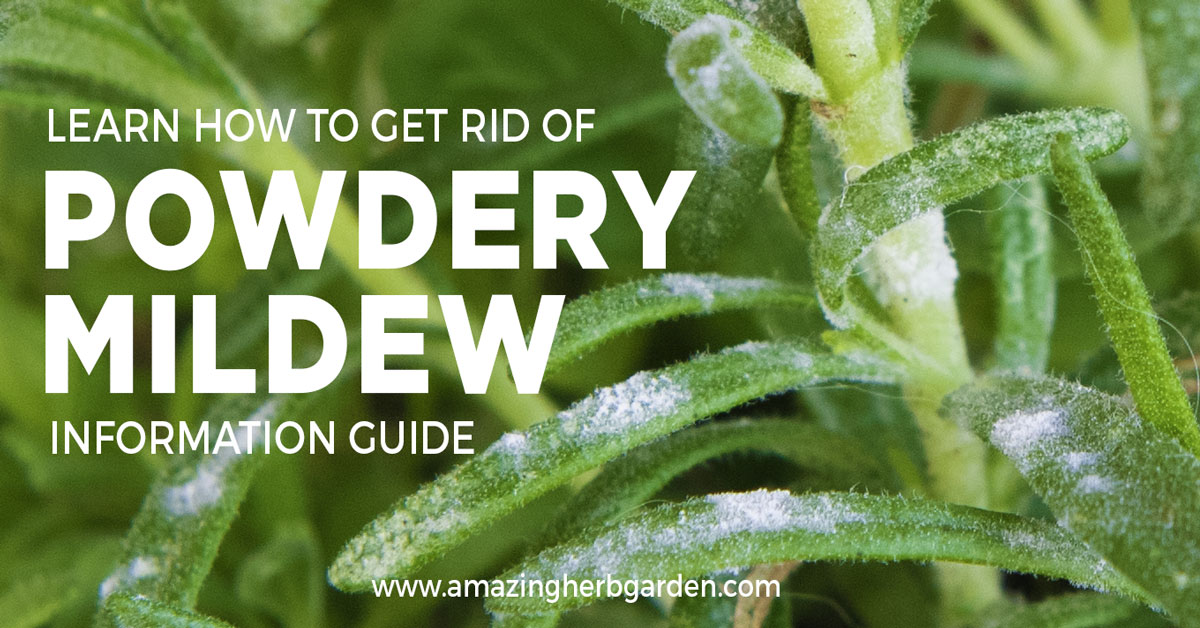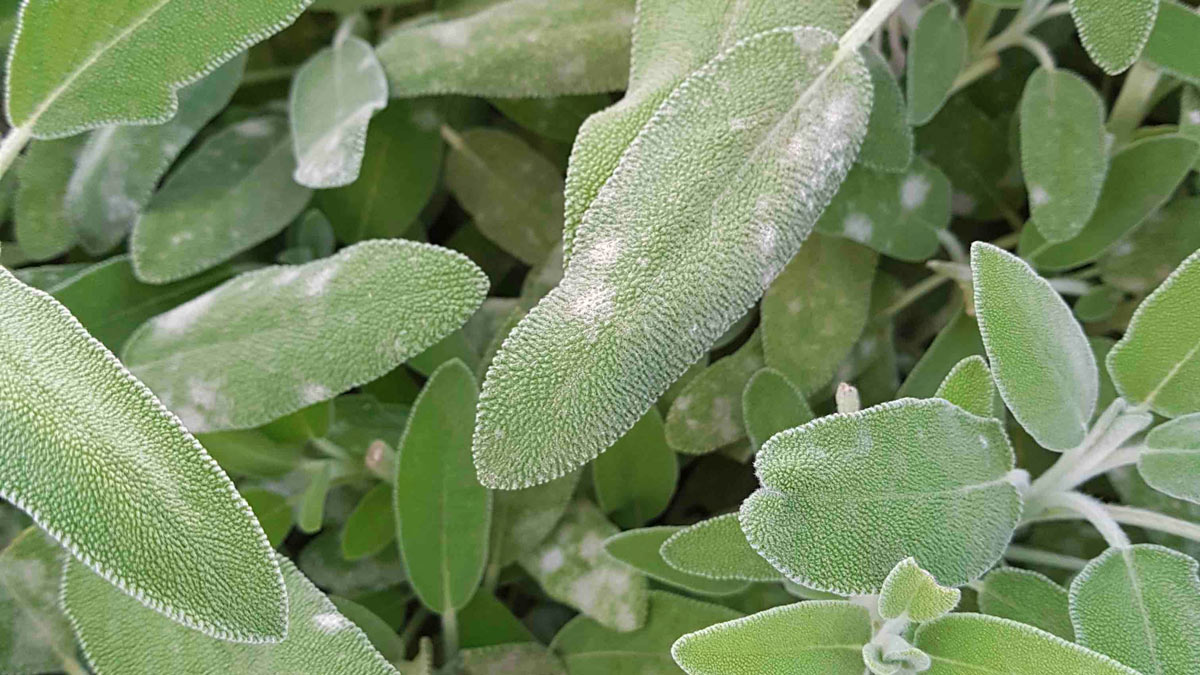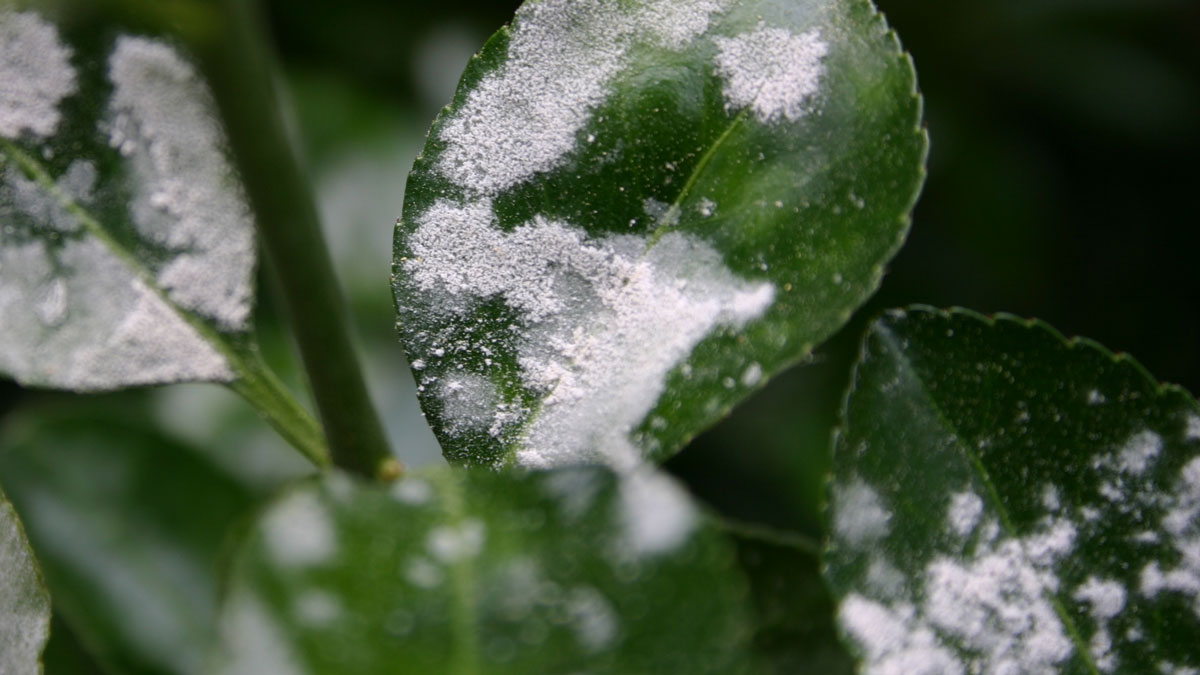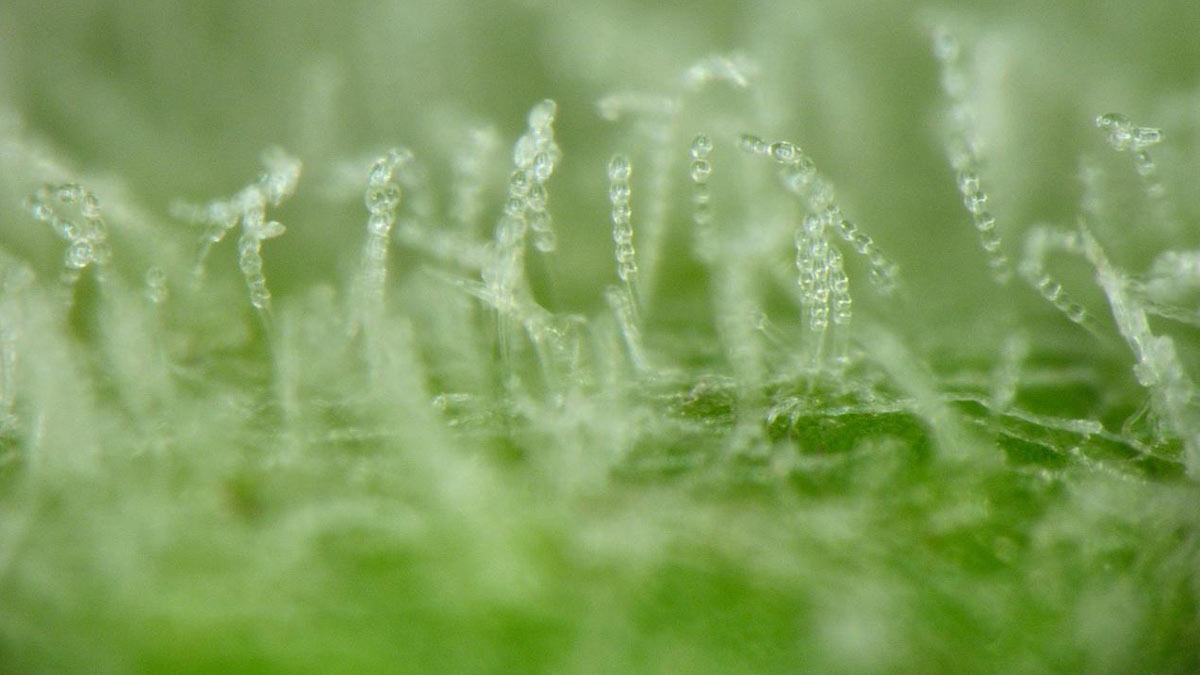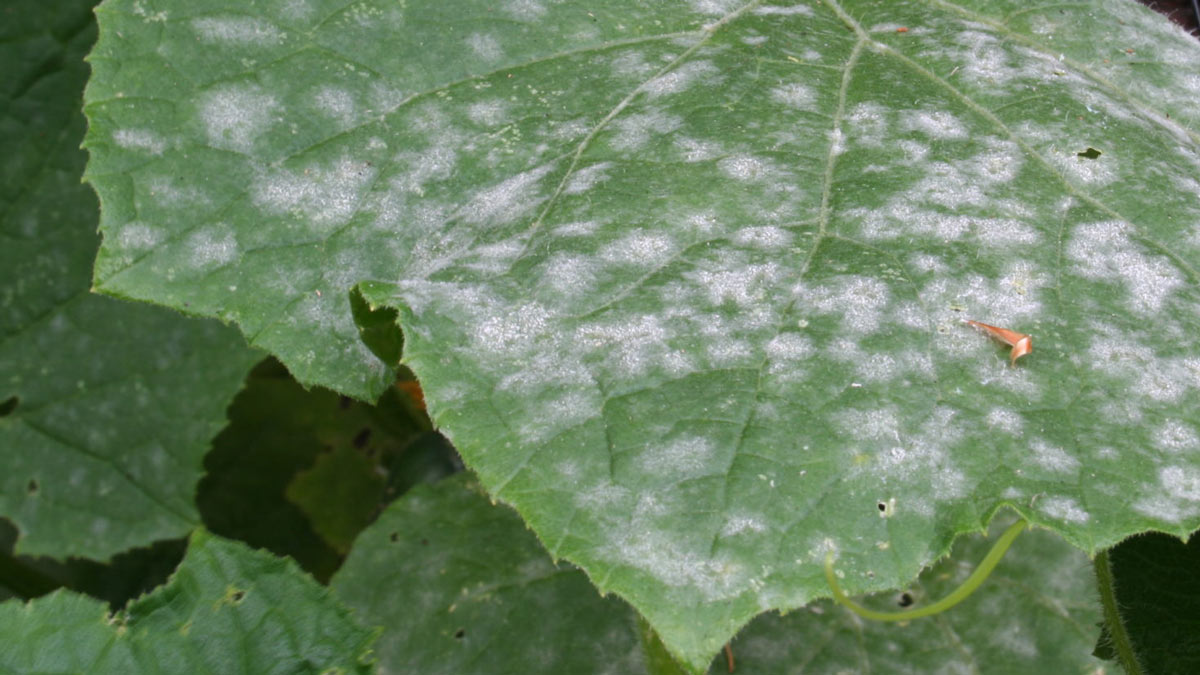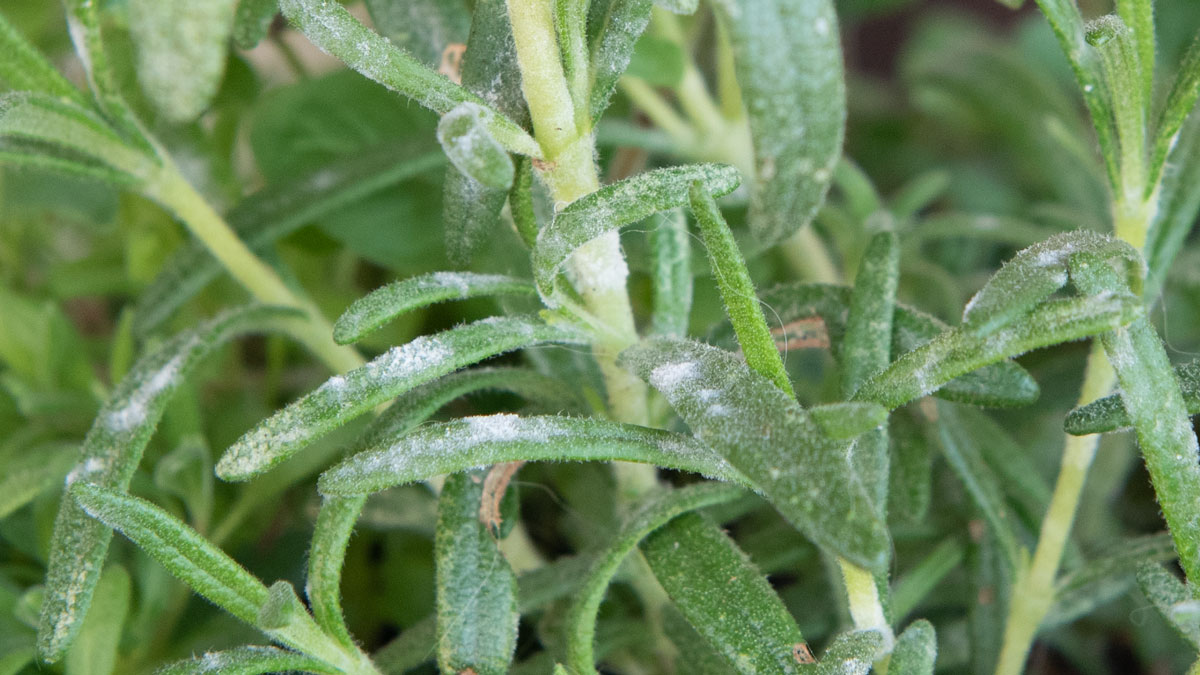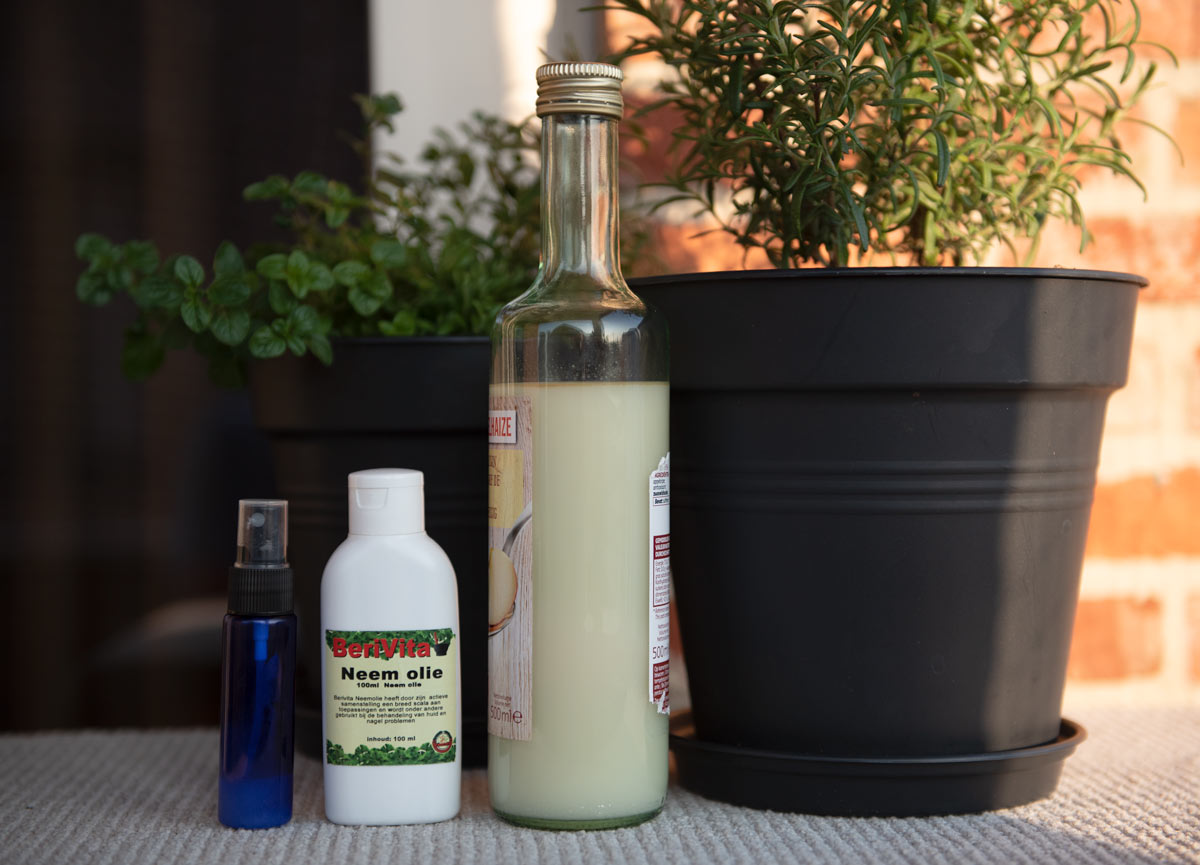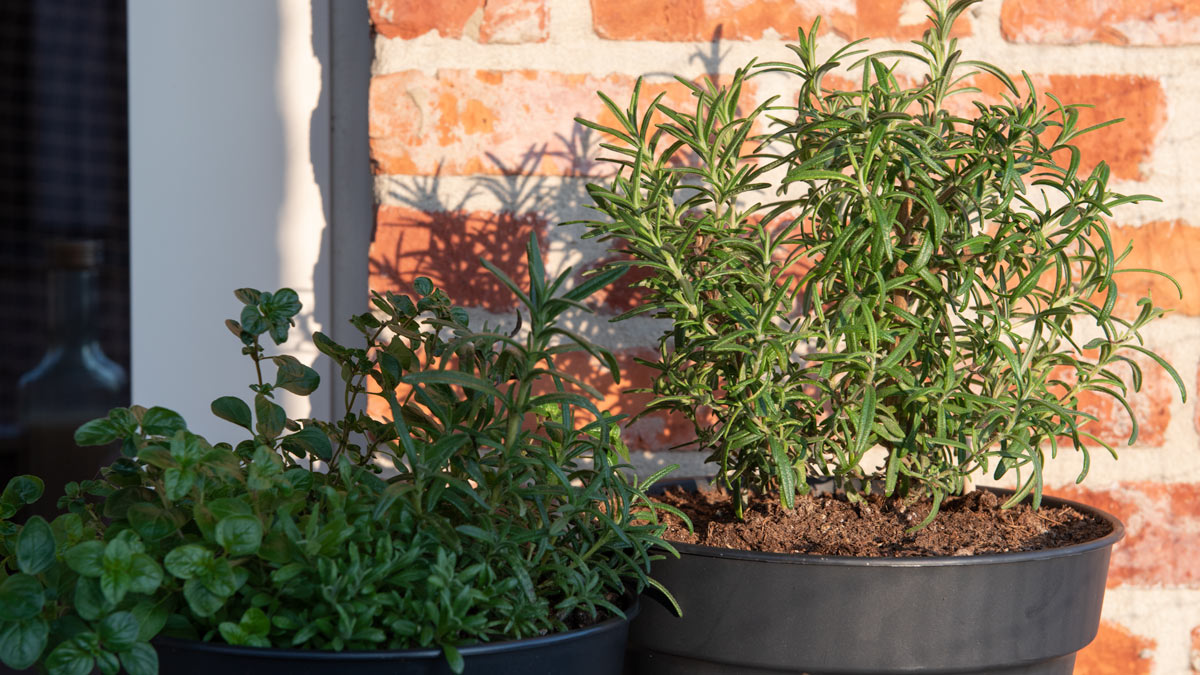Powdery Mildew Treatment for plants and herbs
Based on the number of reactions I have got on my picture about the plant fungus known as powdery mildew, I’ve learned that obviously every herb gardener or plant lover is confronted with this disease sooner or later, that a lot of people need more information about this fungal disease and they don’t always know how to get rid of it.
This page aims to provide all the info you need to know as a herb gardener about powdery mildew to avoid it, to control it and to eliminate it when you detect it on your herbs.
Here are the questions you may have that we are going to answer:
- What is powdery mildew? What are powdery mildew symptoms?
- How does powdery mildew occur or where does it come from? What causes powdery mildew?
- How does powdery mildew spread to other plants? Is powdery mildew contagious to other plants?
- What does powdery mildew do to plants? Does powdery mildew kill plants and herbs?
- Is powdery mildew harmful to humans to eat? Will powdery mildew make you sick?
- Does powdery mildew go away on its own?
- How to prevent powdery mildew? When does powdery mildew occur?
- Can powdery mildew be controlled, stopped or cured? When to treat powdery mildew? Is there a powdery mildew treatment? How to remove powdery mildew from plants? Can powdery mildew be wiped off?
- What kills powdery mildew? How to treat powdery mildew on plants? How to get rid of powdery mildew? How to make a powdery mildew spray?
What is powdery mildew? What are powdery mildew symptoms?
Powdery mildew is a common plant disease that affects a wide range of plants and is caused by many different species of fungi. Apparently no plant is really immune to this disease.
Luckily the symptoms of the disease are very recognisable and distinctive, making it easy to detect the disease. As the name implies, powdery mildew produces a white (or grayish) powdery substance that grows on both sides of the leaf surfaces, on stems and buds.
The white fluffy coating consists of superficial woven threads of fungus and chains of spores. If the powdery growth is removed, a brown to black lesion is usually found on the plant surface.
Infected leaves may become twisted, distorted, then wilt and die as a result of infection.
Because a picture says more than a thousand words, let me start this article by showing some pictures of plants and herbs infected with powdery mildew.
This fungal disease often starts unnoticed at the underside of the leaves, and only gets noticed when the top surfaces of the leaves turn powdery. This disease often starts showing with small white patches of powder on the leaves, next these patches will grow steadily, and they can quickly spread also on the stems, flowers and buds.
Early symptoms vary greatly and can include irregular patches of chlorosis (lacking chlorophyll), and lesions that will develop the powdery appearance when it enters the pore production stage. These pre-pore production patches are often confused with nutritional deficiencies, leaf spot diseases or spray injury.
As the disease progresses, the white spots of the fungi will spread to cover most of the leaves and the fungi steals the nutrition of the leaves, which will start to turn pale and yellow and start wilting and drooping. Finally the leaves will often turn brown before they die.
How does powdery mildew occur or where does it come from? What causes powdery mildew?
The fungi that cause Powdery Mildew (such as Erysiphe, Podosphaera, Oïdium, Leveillula), survive as fungal spores (also known as conidia) on leaves, plants, buds and all sorts of plant debris. This different fungi appear all identical to the naked eye, however they differ in the number of spores they produce, the microscopic shape and structures and in the host they prefer.
All fungi produce fungal spores. These are microscopic biological particles that fungi grow in order to be reproduced, serving a similar purpose as seeds for plants.
Spores of powdery mildew can germinate when there is sufficient warmth and humidity to grow. The optimal temperature may differ from type to type of mildew fungi, but it is clear the fungus grows best in warm conditions and a prolonged period of high humidity.
Some sources indicate that high relative humidity and temperatures between 60°F to 80°F (15°C to 27°C) are ideal for powdery mildew development. Temperatures below 50°F (10°C) and above 90°F (32°C) will significantly curb the disease.
Although most fungi produce only a small amount of spores, some fungi are very productive and the spores can even get airborne.
The enormous numbers of spores give the powdery appearance to the fungus and each individual spore is capable of making a new infection.
How does powdery mildew spread to other plants? Is powdery mildew contagious to other plants?
After spores have germinated on the leaf surface of a plant, the fungi will feed on living plant cells, grow and branch out on the leaf surface. The fungi stays in most cases on the outside of the leaves and plants and takes up nutrients from the plant cells, and produces new spores in specific structures on the surface of the leaf. And these structures form the fluffy, white powdery stuff that we see on the leaves of plants and that is known as powdery mildew.
Powdery mildew spreads quite easily as the produced spores are moved by wind over relatively short distances, by rain splashing the spores to other locations on the plant or nearby plants, or even on people and on pets or animals (such as aphids).
Some sources say that the powdery mildew fungi are host specific, which means that if you find it on one plant that it doesn’t always transfer onto other plants. In other words, the fungi of powdery mildew are specialized to infect only plants of one genus or one family.
In my experience this is correct, I have seen powdery mildew affect only my rosemary plant, that was planted together with oregano and lavender in one and the same container.
The spores can also be spread by infected plant parts overwintering on fallen plant parts.
Hence my suggestion to remove the infected plant parts and clean up all of the fallen leaves. These should be bagged and disposed of in the trash because they are a source for further infection.
Inevitably, every gardener will be confronted with this fungal disease. It is important to remember the information on this page..
What does powdery mildew do to plants? Does powdery mildew kill plants and herbs?
Powdery mildew slows down the photosynthesis of the plants. Powdery mildew will not necessarily kill your plants but it will certainly stunt the plant growth, leaves or plant parts can become yellowed and deformed (especially young leaves are sensitive to deformation). In case of very severe infection, all leaves will drop prematurely and the plant can die.
Is powdery mildew harmful to humans to eat? Will powdery mildew make you sick?
Powdery mildew won’t hurt humans if they touch it. It isn’t directly harmful to humans, in the sense that it is poisonous. But still, I will not recommend eating plants or fruits, or using herb leaves that are infected with powdery mildew, because fungi can cause all sorts of allergic reactions for some people.
I wouldn’t recommend using the plant or herb leaves that have been treated by an insecticidal spray to combat powdery mildew as well. I think the reason why is obvious.
Does powdery mildew go away on its own?
Powdery mildew likely clears up with the warmer drier weather. However I haven’t tested this in my herb garden so far.
How to prevent powdery mildew? When does powdery mildew occur?
It seems to be impossible to completely prevent powdery mildew from entering in your herb garden.
This is largely because, as explained above, spores can be carried by the wind and fall on your plants, and if the conditions are right, they will then begin to reproduce.
But adopting some good and basic gardening practices will help to reduce the chances of powdery mildew—or any other disease—from striking hard on your herb garden.
- Plant spacing: Give your plants enough space, because they need breathing room and space to move and grow. If plants are too close together and they are touching, it’s much easier for mildew spores to spread.
- Isolation: as soon as you notice one plant with the fungus, quarantine the plant as soon as possible to prevent the mildew from spreading.
- Bottom watering: water the soil from the bottom upwards and don’t water the top soil or the leaves themselves. This way there isn’t an increase of the surrounding humidity of the plant after watering. Bottom watering can be applied easily for plants in containers; in the garden use a hose on the base of the plants to water the soil instead of using a sprinkler system. It is also wise to water in the morning, so plants and the surrounding soil have a chance to dry during the day, lowering the humidity at night.
- Air circulation: provide enough air circulation around and between the plants will decrease the relative humidity too because it will inhibit the growth of powdery mildew.
- Resistant varieties: growing as much as possible powdery mildew resistant varieties is also one way of preventing the fungus disease on your plants or in your garden.
- Avoid cool shady spots: fungi in general don’t support sun (strong sun rays kill spores) and high temperatures at all, but they are very fond of cool shady spots where they can thrive very well, because these are very often cooler and humid spots.
- Remove infected leaves and plant parts: avoid the fungi from spreading on one plant by removing the infected leaves and by trimming infected plant parts and put them in the bin immediately (don’t compost it). If the plant or herb is overwhelmed by the powdery mildew, I even prefer to remove it completely.
- Clean the growing environment and the tools that you use regularly and thoroughly.
Can powdery mildew be controlled, stopped or cured? When to treat powdery mildew? Is there a powdery mildew treatment? How to remove powdery mildew from plants? Can powdery mildew be wiped off?
The answer to all of the above questions is simple: absolutely.
Powdery mildew can be controlled and cured with relatively inexpensive, homemade remedies that have been proven to work as well as (or even better than) commercial fungicides.
As stated above, downy mildew is a disease that appears in cool, wet conditions and is generally halted by warm, dry, windy weather. The ideal situation for the development of powdery mildew is cool, humid nights followed by hot, dry days. This situation often occurs later in the growing season on outdoor plants, late in the summertime.
Powdery Mildew should be treated as soon as possible. Don’t let the disease spread before you take the required action.
This raises the question whether we can actually remove the fungi or the spores on the leaves and stems. I have successfully used water to rinse and wash off the spores of the leaves and stems so they don’t get the chance to embed onto the leaves. This is easy to do for smaller plants in containers, but for larger plants in the garden, using lots of water is not something that I promote because wet foliage is also often the cause for other fungal diseases.
Rinsing the foliage with water is also just step one in the treatment. This must be complemented with another treatment to kill the fungus.
What kills powdery mildew? How to treat powdery mildew on plants? How to get rid of powdery mildew? How to make a powdery Mildew spray?
I have great results using a homemade spray based on neem oil. Neem oil is an extract from fruits and seeds of the Neem tree, a tree native to the Indian subcontinent.
Neem oil works very well as a natural pesticide. You can easily make your own treatment spray by making a solution of water, neem oil and liquid soap. The solution has the following ratio:
- One gallon of water (3,8 liters)
- One teaspoon of liquid soap (1 x 5 ml)
- Two tablespoon of neem oil (2 x 15 ml)
In the picture above, you can see my treatment solution in the big glass bottle, next to the neem oil flask. And the small blue bottle is my mini-sprayer for treating my herbs in pots.
A second effective treatment is based on the use of baking soda.
Baking soda or sodium bicarbonate is, although the process isn’t understood completely, a very effective treatment of powdery mildew.
A solution of a gallon of water, 1 tablespoon baking soda and 2.5 tablespoons of horticultural oil, makes a 0.5% concentration of bicarbonate, the maximum recommended for control of powdery mildew on most plants and herbs.
The downside of baking soda is the increased bicarbonate in the soil, which leads to a changed acid level in your soil which can prevent the absorption of iron and lead to iron shortage to your plants.
Recent experiments with milk treatment, using fresh cow’s milk diluted with water to a 10% solution, have also given satisfying results in the field of grape growers.
Although we have some options for treating this disease, prevention is still the best medicine, not only with powdery mildew, but with other diseases as well.
Join the community
If you are looking to grow an amazing herb garden, I strongly recommend signing up to our community and gain access to our FREE downloads and regular updates. We want to ensure your success by sharing our tips and tricks with you for growing herbs.
I want to hear your story! Leave us a comment
If, after reading the information above, you still have a question that remains unanswered, then let me know by mail or in the comments below.

